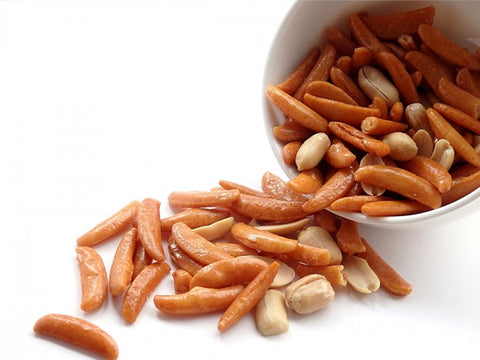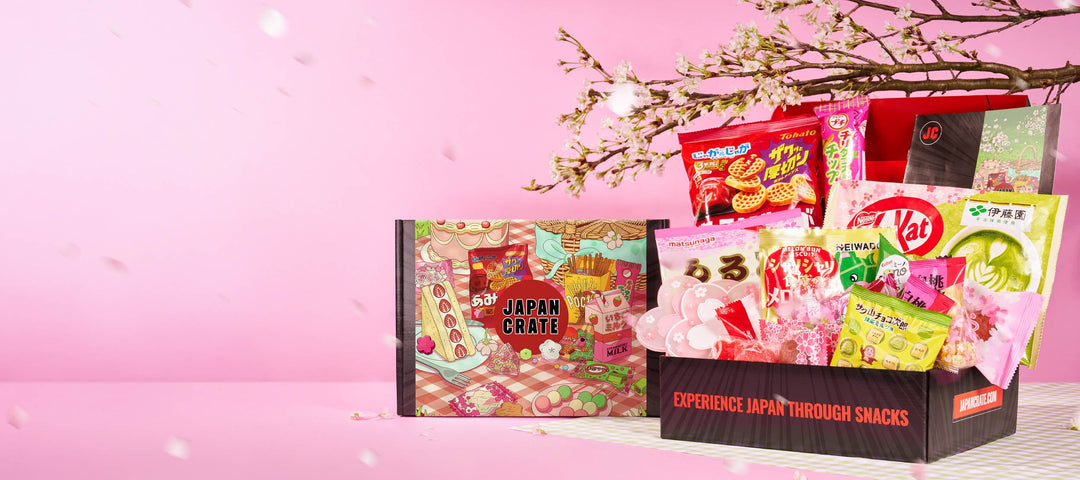Traditional Japanese Snacks
Nowadays, popular Japanese snacks regularly launch new limited edition popular flavors and regional specialties to compete for shelf space at convenience stores and supermarkets in Japan's fiercely competitive snack food sector. Snacks go rapidly in Japan, and they cease producing something just when you start to like it. However, despite the ongoing changes in this setting, some snacks have endured becoming traditional Japanese classics. Typically, delectable and healthful ingredients like rice flour and sweet azuki beans are used to make traditional Japanese snacks. These are the best Japanese snacks that have persisted for many years and have evolved into beloved icons of Japanese culture.

History of Japanese Snack Culture
Samurai created compact, portable snacks with a long shelf life for use in war, which led to the first snack explosion in Japan in the 15th century. The snack market in Japan saw significant development in the 1860s. Markets for imported grains and sugar suddenly became available. As Japan started to industrialize, Western-style snacks were among the first products produced in factories. These treats weren't Western for very long because they quickly blended in with the community. As the nation industrialized, people who worked long shifts used snacks as short energy boosters throughout the day, and their kids also began to purchase snacks more frequently using their parents' pocket money. Snacks became rooted in Japanese society, which led to the current all-time high Japanese snack market.
Let’s dig into the best traditional Japanese snacks!
Taiyaki

A very well-known Japanese dessert that’s quite popular during the cooler season is "taiyaki," a baked Japanese sweet typically stuffed with red bean paste, or anko, and served warm. The treat’s name translates literally as "baked sea bream". However, there is no fish in taiyaki at all! The name actually comes from the fish-shaped mold that the snack is baked into. Taiyaki is commonly found at anyamatsuri, or festival, in the winter, as they’re very easy to hold and can keep you nice and warm!
Taiyaki was created around 100 years ago in Japan, and has since remained a very popular traditional Japanese desserts. The origin of the fish shape is unknown, though some believe that because sea bream fish were very expensive at the time, the snack would make the eater feel as if they were eating a luxury food. Its first big boom in popularity occurred in 1976, and has continued to grow ever since. Taiyaki is quite a simple snack, though there are a variety of possible flavors and fillings. The typical taiyaki is a fried fish-shaped either thick or two thin crisp wafers or pancake with sweet red bean paste on the inside.

Modern versions of taiyaki have given rise to different sweet fillings and flavors. Various flavors are available, including sweet potato, chocolate, and custard. These modern versions will not be complete without mentioning taiyaki ice cream. The taiyaki serves as the cone for pretty much any ice cream flavor, with custard or sweet bean paste at the base of the tail. Some establishments offer more savory ingredients, like cheese, gyza (dumpling) filling, and sausage. All that's left to decide now is what you'll be filling it with and if you'll be biting in the crunchy texture of the heads or tails first!
Arare Japanese Rice Crackers
Arare is a common Japanese snack dish made of rice crackers seasoned with sweet soy sauce glaze and other ingredients. Since the Japanese rice crackers resemble hailstones in size and shape, their name is derived from the Japanese word for "snow particle." The same glutinous rice used in wagashi desserts like mochi gives arare its airy puff and delicate crunch. Arare is gluten-free and is generally consumed with alcoholic beverage, trail mix, or celebration of particular events.

They are frequently offered at occasions like tea ceremonies and come in various sizes, shapes, and flavors—both savory and sweet. Japan offers a wide variety of arare products, including regional varieties and mixed arare that incorporate a variety of flavors and unique ingredients, such as wasabi peas. The first variation is Hina-arare, a colorful assortment of the crackers staple of Hinamatsuri, also known as Doll's Festival. Other variations are round rice crackers covered in tiny bits of dried, toasted nori seaweed salt called Norimaki Arare. Lastly, Kaki no Tane arare, small crescent-shaped chunks of senbei mixed with red peanuts in spicy and umami flavors.

Arare is also well-liked in Hawaii, where it is known as mochi crunch or kakimochi. Early in the 20th century, Japanese immigrants popularized them, where they are sold in cans and are sometimes combined with popcorn to make savory japanese snacks.
Konpeito

You may have seen this colorful, sugary confection in anime, movies, and Japanese markets. It's called Konpeito and is made of simple, unflavored sugar. It was introduced to Japan by Portuguese traders in the 16th century. The word "konpeito" comes from the Portuguese word "confeito," meaning "confection" or "candy." Although the candies are sweet and simple in both flavor and appearance, Konpeito typically takes 7-13 days to produce since they are made by repeatedly coating sugar syrup over a core consisting of a grain of coarse sugar. These little Japanese sugar candies in the shape of stars were expensive and hard to find at the time since sugar was insufficient. Konpeito candies are now utilized for festivities and offered in shrines as gifts.
The Imperial House of Japan even gives the sugary sweet popular snack as a thank-you gift to high-profile contacts, usually in a small, nice box. These candies are available in various colors, including white, orange, pink, yellow, purple, blue, and blue. The taste is often the same regardless of this. Konpeito initially had a taste similar to simple sugar, but these candies now come in a variety of sweet flavors to cater to various markets. They include yogurt, mango, cherry, peach, strawberry, japanese plum, and vanilla. Only during specific seasons are the limited edition Konpeito created. You can certainly snack on Konpeito, but many use it as a sweetener, like in coffee or tea.

Despite being around for 400 years, konpeito remains a beloved and well-liked candy. With its great popularity and cute appearance, Konpeito has been seen in many animes and mangas. The flavor, taste, and look have not changed at all during this time. Modern technology has led to new packaging developments and flavors, luring more customers from local and abroad.
Mochi

Mochi is always the answer when it comes to traditional Japanese sweets. The "rice cake" in this classic Japanese delicacy is its most well-known feature. By boiling sticky rice that has been processed into dessert granules, mochi, or Japanese rice cake, is created. It has a long history of being renowned as an essential event cuisine for the New Year. Mochi can be made in a broad range of shapes and in an equal number of techniques, all of which vary by area.
Mochi can be consumed in so many different ways is one of its excellent qualities. You can take advantage of the additional nutritious value of other foods by adding it to soup or combining it with radish or natto. Mochi often comes in two shapes: maru-mochi, which is round, and kaku-mochi, which is square. Some border prefectures allow consumption of both varieties of mochi, with the east typically favoring kaku-mochi and the west typically favoring maru-mochi.

Mochi is eaten with a variety of various traditional sweet filling in Japan and around the world, such as white beans, milk chocolate, red bean paste, lychee, and peanut. Cooks are having fun experimenting with the adaptable dough by flavoring mochi with flavors like Japanese chocolate, Thai tea, plum wine, black sesame, and durian as it gains popularity throughout the world, and ice cream filling is no exception. A thin layer of mochi is placed on top of an ice cream base that is typically composed of green tea or any ice cream flavors of your choice.
Try the Traditional Japanese Snacks Now!
Fill yourself on delicious, traditional Japanese snacks! These delectable delicacies have endured through the ages in Japan and are now adored by people everywhere, from deep-fried rice crackers and Japanese potato chips, Tokyo banana, Japanese kit kats, and melon pan, to individually wrapped biscuit sticks and caramel corn puffs. You can enjoy these treats with a hot cup of green tea or any beverages you enjoy! You can purchase many traditional Japanese snacks instantly by clicking this link. We have many great deals you can enjoy! Perhaps you'd like to have a package of treats with a Japanese theme sent to your house each month? Just click this link to sign up right now. Japan Crate will bring you the taste of Japan in no time with our fast and flexible international shipping options. Visit our website japancrate.com for additional information. So, what is your favorite traditional Japanese snack? Share your thoughts in the comments below!
10 comments
Author Bio







Hooray! We agree, it’s hard to put them down! Be sure to enter our Moko Moko Toilet Candy contest —> http://bit.ly/1JRDqAa
We’re so glad to make you this happy! Our goal is to provide everyone with a litte glimpse of Japanese culture every month. Enjoy! (✿♥‿♥)
Oh my goodness we are in love with the Sweet Corn Pretz! We are trying not to eat the entire thing before we’ve had a chance to share them with family who are on vacation. And as a personal note I love the toilet even though we haven’t tried it yet. We thought about picking one up at FYE, I am so glad we waited.
I’ve been wanting to try traditional Japanese snacks for so long, and now September’s crate has finally granted my wish! Thank you Japan Crate for helping me pursue my passion of cultural exploration! Arigatoo gozaimasu!! (^u^)
It looks sooo good! (✪㉨✪)
Leave a comment